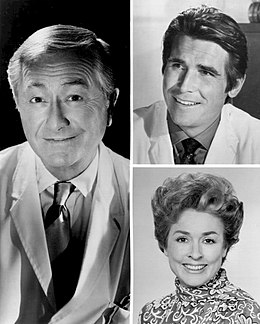Marcus Welby, M.D.
| Marcus Welby, M.D. | |
|---|---|
 Marcus Welby, M.D. title card | |
| Created by | David Victor |
| Starring | Robert Young James Brolin |
| Theme music composer | Leonard Rosenman |
| Country of origin | United States |
| Original language | English |
| No. of seasons | 7 |
| No. of episodes | 170 (list of episodes) |
| Production | |
| Executive producer | David Victor |
| Producer | David J. O'Connell |
| Camera setup | Single-camera |
| Running time | 60 minutes |
| Production company | Universal Television |
| Original release | |
| Network | ABC |
| Release | September 23, 1969 – May 4, 1976 |
Marcus Welby, M.D. is an American medical drama television series that aired on ABC from September 23, 1969, to May 4, 1976. It starred Robert Young as the title character, a family practitioner with a kind bedside manner, who made house calls and was on a first-name basis with many of his patients; James Brolin as his partner Steven Kiley, a younger doctor; and Elena Verdugo as Consuelo Lopez, Welby and Kiley's dedicated and caring nurse/office manager.
Marcus Welby, M.D. was produced by David Victor and David J. O'Connell through Universal Television, which was then an MCA company. The pilot, titled "A Matter of Humanities", had aired as an ABC Movie of the Week on March 26, 1969.
Overview
[edit]As with most medical dramas of the day, the plots often concerned a professional conflict between well-meaning physicians. Here, Welby's unorthodox way of treating patients was pitted against the more straight-laced methods of Kiley (Brolin). The catch with this particular program was that the roles were reversed in that Kiley was much younger than Welby. The opening credits of each episode reminded viewers of the generation gap between the two doctors, Welby driving his sedan and Kiley riding a motorcycle. Welby had served in the US Navy as a doctor during the war, and was a widower.
The doctors worked alongside each other in their private practice in Santa Monica, California, regularly working in conjunction with the nearby Lang Memorial Hospital. (This was later revealed in exterior shots to be the real-life Saint John's Hospital and Health Center in Santa Monica.) At the office, their loyal secretary-nurse and friend was Consuelo Lopez (Verdugo). Other characters that appeared throughout the series included Dr. Welby's frequent girlfriend Myra Sherwood (Anne Baxter), his daughter Sandy (originally Christine Belford, and later Anne Schedeen) and her son Phil (Gavin Brendan), and Kathleen Faverty (Sharon Gless), an assistant program director at the hospital, who worked closely with Welby and Kiley. Kiley met and married public relations director Janet Blake (played by Pamela Hensley) in 1975, at the beginning of the show's final season on the air.

In the episode "Designs", which aired on March 12, 1974, Young was reunited with his Father Knows Best co-star, Jane Wyatt; she played a fashion designer whose marriage to an embittered paraplegic led her to fall in love with the doctor while keeping her marriage a secret most of the episode.
Medical features
[edit]Its handling of many varied medical cases – some common, some uncommon – made it an instant hit for ABC. Story lines included impotence, depression, brain damage, breast cancer, mononucleosis, teenaged obesity, juvenile diabetes, sexually transmitted diseases, epilepsy, learning disabilities, leukemia, haemophilia, paraplegia, dysautonomia, rape, Alzheimer's disease, and addiction to painkillers, among others. At its second season (1970–1971), it ranked number one in the Nielsen ratings, becoming the first ABC show to top the list. The same year, both Young and Brolin won Emmy Awards for their work, as did the show for Outstanding Dramatic Series. Young won a Golden Globe in 1972 for his performance. Members of the American Academy of Family Physicians served as technical advisers for the series and reviewed every script for medical accuracy.
Politics
[edit]The 1973 episode "The Other Martin Loring" was about a middle-aged man whom Welby advised to resist his homosexual impulses. The Gay Activists Alliance (GAA) zapped ABC, occupied its New York headquarters and picketed.[1] The next year, "The Outrage" was a story of a teenaged student who was sexually assaulted by his male teacher, associating homosexuality with pedophilia. Seven sponsors refused to buy television advertising time, and 17 television network affiliates refused to air the episode.[2][3] This was the first known instance of network affiliates refusing a network episode in response to protests.[4]
In addition, an episode dealing with abortion was refused by San Diego area ABC affiliate XETV, a station licensed to Tijuana across the border in Mexico, due to that country's stance on the practice at the time.[5]
Episodes
[edit]
| Season | Episodes | Originally aired | ||
|---|---|---|---|---|
| First aired | Last aired | |||
| Pilot | March 26, 1969 | |||
| 1 | 26 | September 23, 1969 | April 14, 1970 | |
| 2 | 24 | September 22, 1970 | March 30, 1971 | |
| 3 | 24 | September 14, 1971 | March 14, 1972 | |
| 4 | 24 | September 12, 1972 | March 6, 1973 | |
| 5 | 24 | September 11, 1973 | March 12, 1974 | |
| 6 | 24 | September 10, 1974 | March 11, 1975 | |
| 7 | 24 | September 9, 1975 | May 4, 1976 | |
| TV films | May 16, 1984 | December 19, 1988 | ||
Crossovers with Owen Marshall, Counselor at Law
[edit]During its run, Marcus Welby, M.D. had two crossover stories with its legal spin-off series, Owen Marshall, Counselor at Law.
In "Men Who Care", Marshall defends the father of Welby's patient when the man is accused of murdering his daughter's boyfriend. In "I've Promised You a Father", Marshall defends Kiley in a paternity suit filed by a nurse claiming that Kiley is the father of her child.
Nielsen ratings
[edit]| Season | Rank | Rating |
|---|---|---|
| 1969–70 | #8[6] | 23.7 |
| 1970–71 | #1[7] | 29.6 |
| 1971–72 | #3[8] | 27.8 |
| 1972–73 | #13[9] | 22.9 |
| 1973–74 | #29 [10] | 19.5 |
| 1974–75 | #53 [11] | 16.6 |
| 1975–76 | #43[12] | N/A |
It was the first show in ABC's history to become the number-one show on television.
Ending of the series
[edit]By the mid-1970s, the popularity of medical dramas began to wane. Ratings for both Marcus Welby, M.D. and CBS's Medical Center began to drop, as did the ratings for daytime dramas General Hospital and The Doctors. Previous episodes initially went into syndication in the fall of 1975 as Robert Young, Family Doctor (to avoid confusion with the first-run episodes still airing on ABC). The show ended its run in 1976 after 169 episodes were made. On an awards show[which?] that year, Young joked publicly, "I knew that it was time to quit when I started taking time off to play golf!"
Television movies
[edit]In 1984, the reunion movie The Return of Marcus Welby, M.D. aired, with Young and Verdugo reprising their roles. The major conflict, aside from interactions with patients, centered around Welby being accused of being too old to retain his medical license safely. Though Brolin was unavailable to reprise his role as Kiley, a statement described as being from him was read before the board that would decide Welby's fate. Another movie was made in 1988, Marcus Welby, M.D.: A Holiday Affair. This last made-for-television film was the last acting role of Robert Young's career.
Home media
[edit]Shout! Factory (under license from Universal Studios) has released the first two seasons of Marcus Welby, M.D. on DVD in Region 1.[13][14]
Mill Creek Entertainment released a 10-episode best-of set entitled Marcus Welby, M.D.: The Best of Season One on March 22, 2011.[15]
| DVD name | Ep # | Release date |
|---|---|---|
| Season 1 | 26 | May 4, 2010 |
| Season 2 | 24 | October 12, 2010 |
References
[edit]- ^ Capsuto, p. 92
- ^ Capsuto, pp. 106–109
- ^ Tropiano, pp. 18–21
- ^ Alwood, p. 150
- ^ Becklund, Laurie (October 29, 1978). "Broadcasters' Battle of the Border – a Lucrative Market Is at Stake". Los Angeles Times.
- ^ "TV Ratings > 1960's". ClassicTVHits.com. Archived from the original on April 11, 2015. Retrieved April 20, 2015.
- ^ "TV Ratings > 1970's". ClassicTVHits.com. Archived from the original on January 11, 2013. Retrieved April 20, 2015.
- ^ "TV Ratings > 1970's". ClassicTVHits.com. Archived from the original on April 11, 2015. Retrieved April 20, 2015.
- ^ "TV Ratings > 1970's". ClassicTVHits.com. Archived from the original on April 11, 2015. Retrieved April 20, 2015.
- ^ "1973-74 Ratings History". The TV Ratings Guide. Archived from the original on July 21, 2018. Retrieved May 1, 2020.
- ^ "1974-75 Ratings History". The TV Ratings Guide. Archived from the original on July 21, 2018. Retrieved May 1, 2020.
- ^ "1975-76 Ratings History". The TV Ratings Guide. Archived from the original on July 21, 2018. Retrieved April 30, 2020.
- ^ "Marcus Welby, M.D. – Shout! Factory Newsletter Announces Spring DVD for Season 1". Archived from the original on January 24, 2010. Retrieved January 23, 2010.
- ^ "Marcus Welby, M.D. DVD news: Announcement for Marcus Welby, M.D. – Season 2". TVShowsOnDVD.com. Archived from the original on April 27, 2015. Retrieved April 20, 2015.
- ^ "Marcus Welby, M.D. DVD news: Announcement for Marcus Welby, M.D.: The Best of Season 1". TVShowsOnDVD.com. Archived from the original on April 27, 2015. Retrieved April 20, 2015.
Bibliography
[edit]- Alwood, Edward (1998). Straight News: Gays, Lesbians and the News Media. Columbia University Press. ISBN 0-231-08437-4.
- Capsuto, Steven (2000). Alternate Channels: The Uncensored Story of Gay and Lesbian Images on Radio and Television. Ballantine Books. ISBN 0-345-41243-5.
- Tropiano, Stephen (2002). The Prime Time Closet: A History of Gays and Lesbians on TV. New York, Applause Theatre and Cinema Books. ISBN 1-55783-557-8.
External links
[edit]- Marcus Welby, M.D. at IMDb (TV Movie/Pilot)
- Marcus Welby, M.D. at IMDb
- The Return of Marcus Welby, M.D. at IMDb
- Marcus Welby, M.D.: A Holiday Affair at IMDb
- Encyclopedia of Television: Marcus Welby, M.D. Archived August 3, 2004, at the Wayback Machine
- Marcus Welby, M.D. episode guide[permanent dead link]
- 1969 American television series debuts
- 1976 American television series endings
- 1960s American drama television series
- 1970s American drama television series
- Best Drama Series Golden Globe winners
- American English-language television shows
- 1970s American medical television series
- Nielsen ratings winners
- Television series by Universal Television
- Television shows set in Santa Monica, California
- Primetime Emmy Award for Outstanding Drama Series winners
- American Broadcasting Company television dramas
